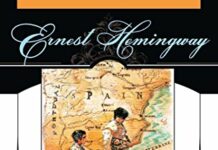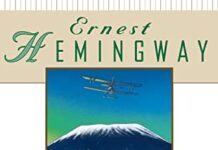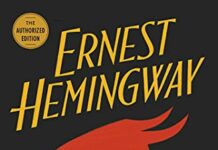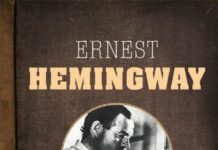
Ebook Info
- Published: 2002
- Number of pages: 496 pages
- Format: EPUB
- File Size: 1.82 MB
- Authors: Ernest Hemingway
Description
Ernest Hemingway’s classic exploration of the history and pageantry of bullfighting, and the deeper themes of cowardice, bravery, sport and tragedy that it inspires.Still considered one of the best books ever written about bullfighting, Death in the Afternoon reflects Hemingway’s belief that bullfighting was more than mere sport. Here he describes and explains the technical aspects of this dangerous ritual, and “the emotional and spiritual intensity and pure classic beauty that can be produced by a man, an animal, and a piece of scarlet serge draped on a stick.” Seen through his eyes, bullfighting becomes an art, a richly choreographed ballet, with performers who range from awkward amateurs to masters of great grace and cunning. A fascinating look at the history and grandeur of bullfighting, Death in the Afternoon is also a deeper contemplation on the nature of cowardice and bravery, sport and tragedy, and is enlivened throughout by Hemingway’s pungent commentary on life and literature.
User’s Reviews
Reviews from Amazon users which were colected at the time this book was published on the website:
⭐This was a gift . My husband was thrilled with the book and it’s condition was like New.
⭐Everyone knows that Hemingway was a “bullfighting aficionado” – well that seems to be the phrase that is most often written. So did you think that, with his journalists curiosity and skills that he spent time learning about the sport (art? theater?) in order to be able to write knowledgeably about it? Perhaps because he knew that it was thought of as exotic and so-very-foreign “back home” in the USA? Because he thought it would be an interesting topic to write about? Nope. At some point in the book he reveals he has been to at least 300 bullfights and seen more than 1,500 bulls killed (I think that every fight has 6 bulls – so perhaps he has seen 1,800 killed). Given the number of bullfights you could possibly go to in a year (Mr Hemingway helpfully lists seasons, dates, locations) he must have been a regular at the fights for many, many years. Yep – Mr. Hemingway it seems was not just an aficionado but was about as obsessed with his chosen sport as even the most ardent NFL fan!He lists out every single quality bull breeder and gives the histories of bulls that were bred better and then worse and so on. He gives the personal and fighting histories of many fighters. The book (kindle) that I have also helpfully had a glossary and many photos as well. This is a man who is not only obsessed with his chosen sport but wants to make sure that the reader really understands everything there is to know about the sport! (art? theater?)I have to confess that after reading it, I had to go watch a couple of youtube videos to see what a real bullfight looks like (youtube seems to be more obsessed with “funny videos” of people getting hurt in fights, so it takes a bit of effort to find a real fight). After just a couple of videos I can’t really see the art or the theater in bullfighting – you probably have to be there (just like Mr Hemingway was, a lot!).At one point in the book he remembers that he is famous for books involving a lot of dialog so brings in an old lady (who complains about the lack of dialog) to introduce dialog and a little bit of humor.Thoroughly recommended whether or not you like bullfighting (or think you might). It didn’t make me want to do more than look up a fight on youtube, but it did make me appreciate Mr. Hemingway even more!
⭐”Death in the Afternoon” is a non fiction account of bullfighting in Spain by Ernest Hemingway. The book combines a detailed, sometimes painful, account of bullfighting with the classic Hemingway writing style. In that context this book provides an interesting juxtaposition to Hemingway novels. While non fiction, there is definite evidence of the Hemingway literary style.Ernest Hemingway seemingly lived a life of the classic, so called, “man’s man” and with that in mind some of this narrative is predictable. Mr. Hemingway does his best to portray bullfighting as a classic and honorable art form, while some readers may find the subject matter cruel and gruesome. There are also some brief asides about other subjects including homosexuality that seemed disparaging. Given the timeframe and the fact that the author is Hemingway, some of that is also predictable. I do not intend to defend bullfighting, but I did find the book educational and I am glad that I read it.I have previously read numerous Hemingway novels and one non fiction, “A Moveable Feast”. As literature I liked this book very much and feel it is an interesting work to compare and contrast to “A Moveable Feast”. Hemingway reveals a good bit about himself and one can tell when Hemingway has “an axe to grind”.In summary, I liked this work as a reading experience and am definitely glad that I read it. I have no intention of defending bullfighting. There are other Hemingway works that I find distasteful, such as the novel “To Have and Have Not” and the short story “Up In Michigan”, works that I did not like either as subject matter or as literature. That is not the case with this book. Thank You…
⭐Death in the Afternoon is a non-fiction book by Ernest Hemingway that explores the ceremony and traditions of Spanish bullfighting. Looking at the history and the culture behind bullfighting, the book also explores the dangers and fears being faced. Still considered one of the best books ever written about bullfighting, Death in the Afternoon explores the sport by one of its aficionados.This is an interesting book, not something I would read normally but I did enjoy it. While I am morally opposed to bullfighting I didn’t have any really knowledge of the sport and culture behind it. So I went into this book with an open mind and a little hesitant. I had never had a good experience with Hemingway in the past; granted I’ve only read one of his novels (The Old Man and the Sea) but it was enough to never go back. I know this is not a good reason not to return but I have to admit I did enjoy the writing styles.Ernest Hemingway has a very descriptive writing style which makes for some interesting insights; but sometimes too much. I get the impression that he is using humour in some of his writing but it’s so obscure that it either goes over my head or is just downright weird. I know Hemingway was a rather unusual man and had an interesting life but he isn’t someone that I think I will ever understand or connect with in any way. While I’m against bullfighting, Hemingway seems to be an advocate towards it and often wants it to be more violent and deadly.You have to understand that Ernest Hemingway is an arrogant, sexist, pompous ass and it often comes through in his writing, so you have to take everything he says with a huge grain of salt. I found myself disagreeing with him all too often but still interested in what he was saying. I went into this book knowing that Hemingway and I weren’t going to get along at times, which was lucky because I was ready to throw out any of his opinions that didn’t align with mine. I did find it interesting how he kept using bullfighting as a metaphor for art and Spain; I don’t know if I agree with this but he seemed was be determined to make this point.While I’m still opposed to bullfighting, I now have a whole lot more information about the topic; possibly too much. Hemingway’s writing style was enough to make me willing to try something else of his (if I find something good) and this was an interesting and different reading experience. I don’t read enough non-fiction, let alone travel or sports writing so this was a book way out of left field. I’m determined to read more non-fiction now and I hope that I manage to get through at least one a month. Also interesting to see how this review turned out; I’m never know how to approach a non-fiction review and I think I did alright here.
⭐”Fiesta” is the one I favour most of all the Hemingway novels, because it is young at heart and old in wisdom. This choice of mine is problematic since it is in spite of my deprecation of bullfighting, and bullfighting is a subject matter that is a substantial part of the book.Hemingway’s foremost objection and argument in ”Death in the Afternoon” to all opponents of bullfighting is that they are in no position to be against it unless they have experienced a live corrida performance, and that any dismission of his argument mainly stem from ignorance. Once I have been to a bullfight. Once I have been standing on the yellow sands in the middle of the deserted red-painted bullring in Ronda, ”the cradle of bullfight” – feeling the magic. Now I have read his beautifully titled and highly knowledgeable book on bullfighting. My experience has left me still against.The focus point of bullfighting today is probably the ethics of its practise which nowadays, of course, is even more controversial than in the 1930s when the book was written. The book contains disappointingly little regular philosophical discussion aroud the moral issue. Instead the book is a mighty exhaustive manual of the terminology, technicalities and choreography of what Hemingway emphasizes is bullfighting as an art form, bordering on religion, and not a sport, at all. Qualities in bullfighting that fascinates Hemingway are bravery and pride, in bull as well as matador, or man, the word he prefers using, and he goes to great lengths describing, very interestingly, those two virtues. If Man has a good day and realizes to play with the bull in a way that displays grace, valor, force, emotion, intelligence, wisdom, exquisiteness, intensity, passion, spirituality, purity, he brings an orgasmic ecstasy to the aficionados and spectators who feel the bullring and the earth move, they have been ”there”, they are witnesses of a miracle.I would say that in bullfighting the bull is regarded as a catharsis element, a living creature is killed under torturing circumstances and treated as a vehicle, or instrument, for personal excitement. The more so called beautiful bravery from the fighting bull, the more of its prestanda, the more the bull is seen as a perfect art object. But making the bull a sacrfice for human’s needs and pleasure is severely an objectifying of the animal. The bull’s natural instinct is to fight, so what the corrida does, Hemingway seems to mean, is just bringing out the bull in the bull, so to speak, the fighting makes the bull maximum bull – and that is regarded as a good way to die, in the sunsetting Afternoon. The bull is saved through the poetry and art of the act. Art demands sacrifice, it’s a truth, but consequently Hemingway’s passion for bullfighting puts esthetics before ethics, a view which seems repellent to me, and not so as a lover of animals, but as a lover of arts.That Hemingway is omitting a probe into moral aspects about bullfighting, is perhaps not unexpected. More surprising might be that the book doesn’t contain much historical background to bullfighting in terms of bull mythology and symbolism. Bullfighting is a tradition from prehistoric times in the Mediterranean, where bulls have been sacrificed in different cults, like the Cretensian and the Mithras, and bulls have symbolized both male strength and virility, as well as its opposite, subjugation of masculinity and animality, under the dominance of different moon-godesses. Hemingway’s credo in life was above all ”Grace under pressure”. You have to go to his biography to get a full understanding of his Grace with a capital ”G”. Why he is indulging in an orgy of bullfighting technicalities and says nothing about bull mythology and cult, has probably something to do with the deep hidden psychological roots of his passion; the whole bullfighting manual is a shield to protect his bare feelings. The omitting is of course also to give credit to his classical new thinking in style of writing, omitting what’s below the surface, only expressing one eight of the iceberg. He avoids moral aspects and psychological motives because he has never been an aficionado of explicit didactic theorizing and intellectualism. Like he says himself:”horseshit, that is unsoundness in an abstract conversation or, indeed, any overmetaphysical tendency in speech”.Bullfighting is mainly about death – and learning to face death without flinching. To succeed in this ordeal is to have Honor. To see Bull and Man in the red-painted bullring united in a graceful and dangerous Natural pass is to Hemingway the most delivering vision imagined. The Man playing close, close with death gives to the spectator a feeling of immortality. The difficulty and exclusive skill of killing beautifully, is a justification of killing the animal that sublimates and ennobles the Bull, Matador and spectator. To kill is the same as challenge existence and thus overcome death, which is followed by the sense of Pride, which is bullfighting in essence. There are good singers and there are bad ones, the same goes for matadors. If they just go through the motions and don’t visualize the soul of the true bullfight they are simply dayworkers or butchers, not dignified killers.It is interesting to meet Heminway as a writer of documentary facts, or journalism, and not fiction. His structure and composition is in ”Death in the Afternoon” far from as tight as in the novels and short stories, but much more rhapsodic and fragmentary. Although his supreme handling of fiction appears in this book too. ”Hundreds” of matadors are passing by, each one in a miniature portrait, everyone originally depicted without any signs of repetition narratively; that is skillful and vigorous writing, and very admirable. His snapshots of the picturesque towns of Spain, like Aranjuez with its tree-shaded streets, Ronda with its setting in a dramatic and romantic landscape, and many more, have got his characteristic sensual and restrained language.Hemingway is an ardent aficionado and brilliant connaisseur of bullfighting and his knowledge is knock-out impressive. His views on it as an art form could be alluring, since it is pure poetry and intensely beautifully described in his perspective. But no, even so, it’s primitive and wrong. Bullfighting is a relic from an age when both humans and animals were sacrificed in cults. To justify a sacrifice of a human being is unthinkable as of today, the same should be a fact about animals. Life is not logic. Still, bullfighting belong at the museum, whether at the Anthropologyor Ethnology museum could be discussed. Nature or culture? Life is not logic.
⭐I had this in paperback – can’t find it, so thought I’d get the Kindle edition instead.Mistake. No contents, chapter listings, pictures. And at the end of the book it lists the last page as 177 of 179.Hopeless – returned for refund. Avoid until it’s transferred to Kindle properly.
⭐I’ve just been to my first bullfight, thought it graceful, brutal, balletic, macho, exquisite, bloody, yet had no idea what it was all about. I bought this book, about which I’d heard much, hoping to find out. The pictures alone are compelling. It was written in 1939 before horses were protected by padding so in Hemingway’s time, the horse would die first. It looked a far more primitive and riskier business that it did in Seville last month. I think I regret the passing of the real-ness of it all but not of the pain all concerned must have experienced at different points in the performances.It is odd that a developed country like Spain still allows bullfights to continue and yet it allows us a brief peek into a world nearly over forever. Hemingway was fascinated by it – I think I am too.
⭐I read “The Sun also Rises” which I enjoyed, have been an Espanofile for many years. Having seen a TV programme which referred to this book I purchased it, but found it to be heavy going and unless you’re into the history of bull fighting from the 1920’s not of great interest. I lasted 4 chapters before dispatching it to the exchange case in the hotel.
⭐A detailed look at a controversial subject, delivered in Hemingway’s unique style. Uncompromising, interesting, though a little long in places. If you don’t like bullfighting, this is not for you; if you have no opinion on it or are undecided, this is an interesting analysis of the sport, the people in it and the culture surrounding it… a culture soon to be lost.
Keywords
Free Download Death in the Afternoon in EPUB format
Death in the Afternoon EPUB Free Download
Download Death in the Afternoon 2002 EPUB Free
Death in the Afternoon 2002 EPUB Free Download
Download Death in the Afternoon EPUB
Free Download Ebook Death in the Afternoon





